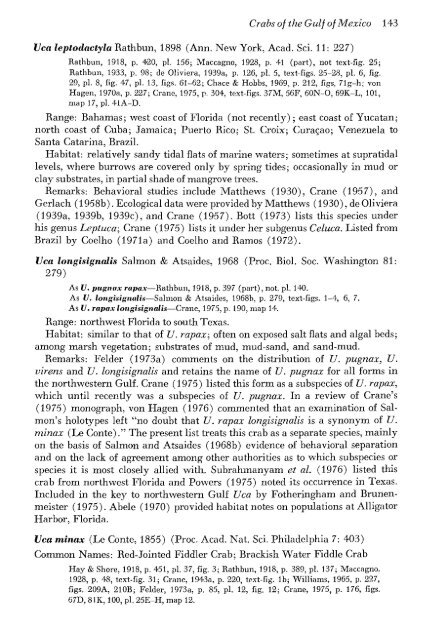Create successful ePaper yourself
Turn your PDF publications into a flip-book with our unique Google optimized e-Paper software.
Crabs of the Gulf of Mexico 143<br />
Vca leplodaclyla Rathbun, 1898 (Ann. New York, Acad. Sci. 11: 227)<br />
Rathbun, 1918, p. 420, pi. 156; Maccagno, 1928, p. 41 (part), not text-fig. 25;<br />
Rathbun, 1933, p. 98; de Oliviera, 1939a, p. 126, pi. 5, text-figs. 25-28, pi. 6, fig.<br />
29, pi. 8, fig. 47, pi. 13, figs. 61-62; Chace & Hobbs, 1969, p. 212, figs, 71g-h; von<br />
Hagen, 1970a, p. 227; Crane, 1975, p. 304, text-figs. 37M, 56F, 60N-O, 69K-L, 101,<br />
map 17, pi. 41A-D.<br />
Range: Bahamas; west coast of Florida (not recently); east coast of Yucatan;<br />
north coast of Cuba; Jamaica; Puerto Rico; St. Croix; Curasao; Venezuela to<br />
Santa Catarina, Brazil.<br />
Habitat: relatively sandy tidal flats of marine waters; sometimes at supratidal<br />
levels, where burrows are covered only by spring tides; occasionally in mud or<br />
claj' substrates, in partial shade of mangrove trees.<br />
Remarks: Behavioral studies include Matthews (1930), Crane (1957), and<br />
Gerlach (1958b). Ecological data were provided by Matthews (1930), de Oliviera<br />
(1939a, 1939b, 1939c), and Crane (1957). Bott (1973) lists this species under<br />
his genus Leptuca; Crane (1975) lists it under her subgenus Celuca. Listed from<br />
Brazil by Coelho (1971a) and Coelho and Ramos (1972).<br />
Vca longisignalis Salmon & Atsaides, 1968 (Proc. Biol. Soc. Washington 81:<br />
279)<br />
As U. pugnax rapax—Rathbun, 1918, p. 397 (part), not. pi. 140.<br />
As U. longisignalis—Salmon & Atsaides, 1968b, p. 279, text-figs. 1-4, 6, 7.<br />
As U. rapax longisignalis—Crane, 1975, p. 190, map 14.<br />
Range: northwest Florida to south Texas.<br />
Habitat: similar to that of U. rapax; often on exposed salt flats and algal beds;<br />
among marsh vegetation; substrates of mud, mud-sand, and sand-mud.<br />
Remarks: Felder (1973a) comments on the distribution of U. pugnax, U.<br />
virens and U. longisignalis and retains the name of U. pugnax for all forms in<br />
the northwestern Gulf. Crane (1975) listed this form as a subspecies of U. rapax,<br />
which until recently was a subspecies of U. pugnax. In a review of Crane's<br />
(1975) monograph, von Hagen (1976) commented that an examination of Salmon's<br />
holotypes left "no doubt that U. rapax longisignalis is a synonym of U.<br />
minax (Le Conte)." The present list treats this crab as a separate species, mainly<br />
on the basis of Salmon and Atsaides (1968b) evidence of behavioral separation<br />
and on the lack of agreement among other authorities as to which subspecies or<br />
species it is most closely allied with. Subrahmanyam et al. (1976) listed this<br />
crab from northwest Florida and Powers (1975) noted its occurrence in Texas.<br />
Included in the key to northwestern Gulf Uca by Fotheringham and Brunenmeister<br />
(1975). Abele (1970) provided habitat notes on populations at Alligator<br />
Harbor, Florida.<br />
Vca minax (Le Conte, 1855) (Proc. Acad. Nat. Sci. Philadelphia 7: 403)<br />
Common Names: Red-Jointed Fiddler Crab; Brackish Water Fiddle Crab<br />
Hay & Shore, 1918, p. 451, pi. 37, fig. 3; Rathbun, 1918, p. 389, pi. 137; Maccagno.<br />
1928, p. 48, text-fig. 31; Crane, 1943a, p. 220, text-fig. lb; Williams, 1965, p. 227,<br />
figs. 209A, 210B; Felder, 1973a, p. 85, pi. 12, fig. 12; Crane, 1975, p. 176, figs.<br />
67D, 8IK, 100, pi. 25E-H, map 12.

















